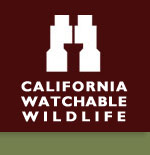

| Visitation: 829,847 | ||
| Area: 59 Acres | ||
| Lat: | ||
| Lon: | ||
| Nearby Services | ||
| Site Facilities | ||
| Join Our Mailing List |
|
For Email Marketing you can trust
|
Top Banner Photo Credits
Pam Starr
Alyn Robert Brereton
Julie MacKinnon
Linda Pittman
Parham Pourahmad
Larry Whiting
Randall Finley
Pam Starr
Alyn Robert Brereton
Julie MacKinnon
Linda Pittman
Parham Pourahmad
Larry Whiting
Randall Finley
© 2008-2024 California Watchable Wildlife and Blue Cat Studio, Inc.
| Natural Bridges State Beach - Site # 148 | |||
| Natural Bridges State Beach by California State Parks is an excellent vantage point for viewing shore birds, migrating whales, as well as seals and otters playing offshore. Further along the beach, public access tidepools offer a glimpse of life beneath the sea. Low tides reveal sea stars, shore crabs, sea anemones, and other colorful ocean life. The park also includes a large area of coastal scrub and grasslands, with bright native wildflowers in the spring. Moore Creek flows through the park, forming freshwater wetlands and a salt marsh before it reaches the sea. | |||
|
| |||
| Background: | A wave-sculpted sandstone bridge, rocky tidepools, and sandy beach create a dramatic setting for one of the United States' largest monarch butterfly wintering sites, sometimes attracting as many as 100,000 butterflies. Monarchs pass the winter clustered on eucalyptus trees and are easily viewed on guided tours from the Monarch Trail boardwalk. The Milkweed Patch offers a close look at developing chrysalises and caterpillars. Secret Lagoon, a tranquil rainwater marsh, attracts mallards, great blue herons, green herons, and red-winged blackbirds. Tidepool tours reveal sea stars, tunicates, sponges and other marine life. Watch offshore for cormorants, gulls, black oystercatchers, brown pelicans, harbor seals, even occational southern sea otters. | ||
| The Habitat: | The park's Monarch Grove provides a temporary home for thousands of Monarchs. In 2016, 8,000 Monarch Butterflies overwintered at Natural Bridges. From late fall into winter, the Monarchs form a "city in the trees." The area's mild seaside climate and eucalyptus grove provide a safe place for monarchs to roost until spring. In the spring and summer, the butterflies live in the valley regions west of the Rocky Mountains where the monarch's companion plant, milkweed, is found. For most of the year, where there are monarchs, there are also milkweed plants. Monarchs drink nectar from milkweed flowers, and female monarchs lay their eggs on milkweed leaves. Milkweed contains a toxin that, when ingested by the caterpillar, makes it toxic to other animals. These toxins remain in the butterfly as well, providing protection from predators that would otherwise eat the monarchs. | ||
| The Experience: | The tide pools at Natural Bridges State Beach are filled to the brim with thousands of creatures, each one doing its best to survive in a constantly changing environment. The moon's gravity pulls on the tides twice daily, converting this habitat from a fully submerged underwater world to an arid and exposed rocky shore. Salinity levels skyrocket and hungry predators swoop in for a tasty meal. These tide pools are preserved and protected by law as part of a Marine Protected Area, which will help maintain their pristine state for generations to come. Stop by at low tide to view this awesome display of nature's resiliency. | ||
| Wildlife and Where to Find It: | Trails and overlook Most people visit Natural Bridges because of remarkable views of monarch butterflies. Those who head for the beach are treated to guided tours that explore the flora and fauna of rock-bound tidepools inhabited by starfish, anemones, and other marine life. | ||
| Viewing Tips: | Butterflies are seen from October through February. Tidepools provide excellent viewing at low tide. Look for wading birds and marine birds year-round; high probability of seeing waterfowl in winter and spring. Visitor center. Make tour reservations. DO NOT TOUCH BUTTERFLIES OR CHRYSALISES. WATCH FOR POISON OAK. DON'T DISTURB TIDEPOOL LIFE. DANGEROUS SURF AND SLIPPERY ROCKS. | ||
| Nearby Viewing Sites: | Año Nuevo State Reserve | ||
| Festivals & Events: | Welcome Back Monarch Days | ||
| Visitor Information: | Visit Santa Cruz - 831.425.1234 - https://www.santacruz.org/ | ||
| Viewing Site Hours of Operation are: | |||
| Staff On-site: | Yes | ||
| Open: | Everday | ||
| Hours: | sunrise - sunset | ||
| Year Round: | Yes | ||
| Road Information: | |||
| Road Hazards: | |||
| Parking Fee: Yes | |||
| Proximity to viewing area:300' | |||
| Parking Notes: | |||
| How to Get There: | In Santa Cruz, drive north on Highway 1 (Mission Street). turn left on Swift Street, right on Delaware, then left on Swanton. Parking available outside entry and within park. | ||
| Contact Information | |||
| Managing Agency: | California State Parks | ||
| Agency Site URL: | https://www.parks.ca.gov/?page_id=541 | ||
| Physical Address: | 2531 West Cliff Drive Santa Cruz, CA 95060 |
Agency 2: | same , CA |
| Manager Phone: | |||
| Site Phone: | (831) 423-4609 | ||
| County: | Santa Cruz | ||
| Addition Website: | |||
